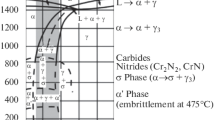Abstract
We study the composition of surface films and deposits in corrosion cracks that appear in the stud holes of the flanges of collectors of steam generators of nuclear power stations. The corrosion cracking susceptibility of 08Kh18N10T austenitic steel is found under conditions of cyclically varying temperature under the attack of water, chloride, alkaline, and boric acid solutions, etc. Data of electrochemical investigations are presented. We also determine local concentrations of residual hydrogen and the type of structural transformations. It is shown that fracture of collector materials is caused by alkaline cracking activated by the local depassivating action of chloride ions.
Similar content being viewed by others

References
V. L. Bogoyavlenskii,Steel Corrosion in Nuclear Power Stations with Water Heat Carriers [in Russian], Énergoatomizdat, Moscow (1984).
V. V. Gerasimov,Corrosion of Reactor Materials [in Russian], Atomizdat, Moscow (1980).
R. K. Melekhov,Corrosion-Resistant Steels and Alloys for Equipment and Pipelines of Nuclear Power Stations [in Russian], Naukova Dumka, Kiev (1983).
OST 108.901.01-79,Metals. Test Methods for Corrosion Cracking in Nuclear and Thermal Power Industry, Introduced 01.07.1980.
W. L. Clarke and G. M. Gordon, “Investigation of stress corrosion cracking susceptibility of Fe-Ni-Cr alloys in nuclear reactor water environments,”Corrosion,29, No 1, 1–12 (1973).
J. Danko, “Protection against stress corrosion cracking in the USA,”Nucl. Eng. Internat., No 6, 27–32 (1984).
S. H. Bush, “Stress corrosion in nuclear systems,” in:Stress Corrosion Cracking Problems in Primary Pressure System. Reports of Technical Comm. Meeting, Palo Alto, USA (1976), pp. 29–31, Vienna, IAEA, IWG-RRPC-78/2 (1978), pp. 115–120.
A. V. Vasylyk, R. K. Melekhov, and R. G. Moiseev, “Distinctive features of the electrochemical behavior of KhN35VT alloy in hot solutions with high pH values,”Fiz.-Khim. Mekh. Mater.,27, No. 3, 74–76 (1991).
A. B. Vainman, R. K. Melekhov, and O. D. Smiyan,Hydrogen Embrittlement of Elements of High-Pressure Boilers [in Russian], Naukova Dumka, Kiev (1990).
MR 185–86,Strength Calculations and Tests. Test Methods for Corrosion Cracking Susceptibility of Steels and Alloys in Liquid Media [in Russian], VNIINMASh, Moscow (1986).
I. I. Vasilenko and R. K. Melekhov,Corrosion Cracking of Steels [in Russian], Naukova Dumka, Kiev (1977).
D. Briggs and M. P. Siekh (editors),Analysis of a Surface by Means of Auger- and X-Ray Photoelectron Spectroscopy Methods [Russian translation], Mir, Moscow (1987).
A. V. Vasylyk, S. I. Girnyi, and R. K. Melekhov, “The role nickel and chromium in the active-passive transition in low-strength steels in the media with high pH values,”Fiz.-Khim. Mekh. Mater.,25, No. 1, 43–47 (1989).
R. K. Melekhov, A. M. Krutsan, and M. V. Koval', “Thermodynamics of the process of alkaline cracking and local corrosion in low-alloyed steels,”Fiz.-Khim. Mekh. Mater.,17, No. 6, 3–10 (1981).
I. I. Vasilenko, A. M. Krutsan, and R. K. Melekhov, “The use of ϕ - pH diagrams in clarifying the mechanism of local corrosion processes,”Vestnik Akad. Nauk Ukr. SSR, No. 11, 12–21 (1983).
D. D. Macdonald, B. C. Syrett, and S. S. Wing, “The use of potential-pH diagrams for the interpretation of corrosion phenomena in high-salinity geothermal brines,”Corrosion,35, No. 1, 261–281 (1979).
H. V. Chumalo and S. U. Girnyi, “Sulfide cracking of austenitic chrome-manganese-nickel and chrome-manganese steels,”Fiz.-Khim. Mekh. Mater.,24, No. 3, 113–115 (1988).
K. L. Brian and S. K. Benordji,Embrittlement of Structural Steels and Alloys [in Russian], Metallurgiya, Moscow (1988).
S. Ahmad, M. L. Mehta, S. K. Safar, and I. P. Saraswat, “Stress corrosion cracking of sensitized 304 austenitic stainless steel in sulfurous acid,”Corrosion,37, No. 7, 412–415 (1981).
F. P. Ford and M. J. Povich, “The effect of oxygen temperature combinations on the stress corrosion susceptibility of sensitized type 304 stainless steel in high purity water,”Corrosion,35, No. 12, 569–574 (1979).
Additional information
Karpenko Physicomechanical Institute, Ukrainian Academy of Sciences, L'viv. Translated from Fiziko-Khimicheskaya Mekhanika Materialov, Vol. 30, No. 1, pp. 113–122, January–February, 1994.
Rights and permissions
About this article
Cite this article
Melekhov, R.K., Smiyan, O.D. Corrosion cracking of 08Kh18N10T steel under the operating conditions of steam generators of nuclear power stations. Mater Sci 30, 115–126 (1995). https://doi.org/10.1007/BF00559026
Received:
Issue Date:
DOI: https://doi.org/10.1007/BF00559026


